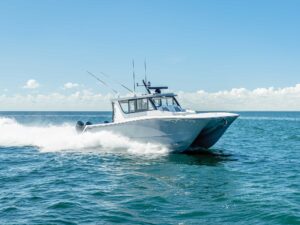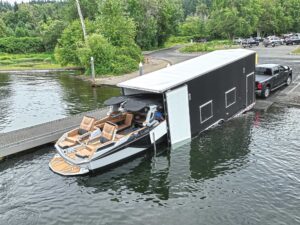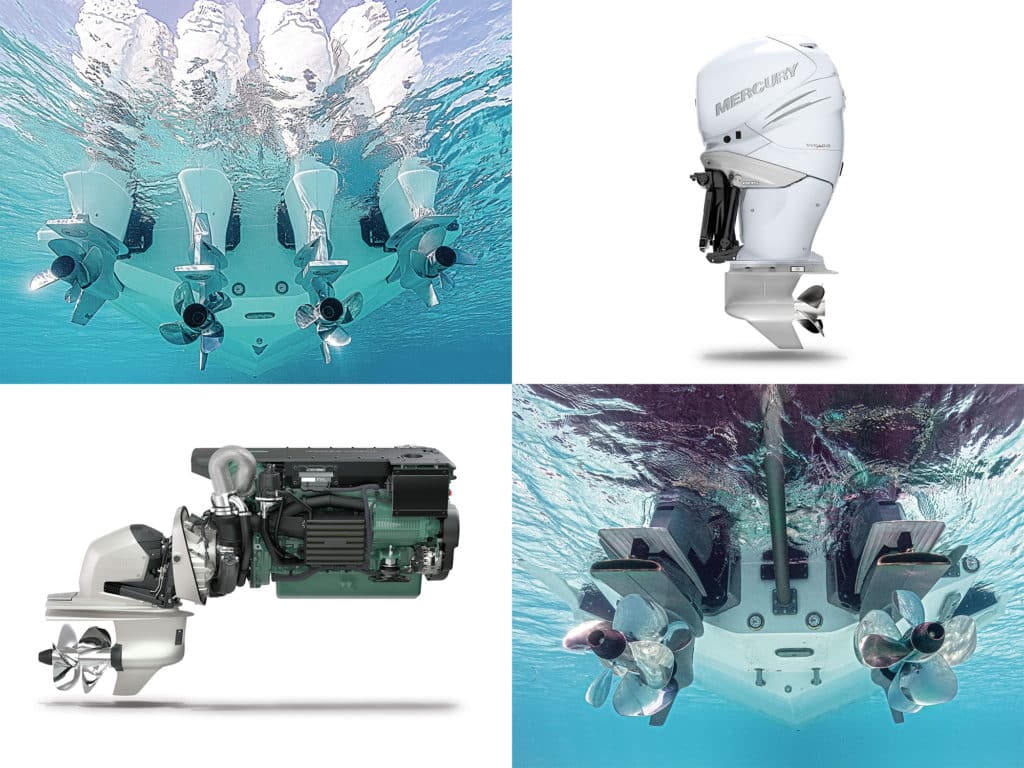
There’s little question that the gasoline-fueled outboard engine currently ranks as the most popular power choice for for large center-consoles, whether used as hardcore fishing boats, spacious multipurpose dayboats or tenders for large yachts. It’s certainly true that outboards represent some of the most advanced marine propulsion available. They run quietly and virtually smoke-free. They deliver outstanding power for their weight, along with low drag and trimmable thrust, all of which contributes to their great efficiency. But do these attributes and others make outboards the best choice?
Not according to Volvo Penta. The longtime manufacturer of marine engines debuted its diesel Aquamatic system to challenge the outboard’s ascendancy. Partnering with Sōlace Boats, Volvo Penta installed the first pair of diesel Aquamatics in Sōlace’s 415 CS, a 41-foot center-console. It’s long established that diesel engines offer great efficiency, reliability and durability. The Aquamatic drives also offer low drag and trimmable thrust to rival that of outboards. And the diesel Aquamatic system delivers other benefits too.
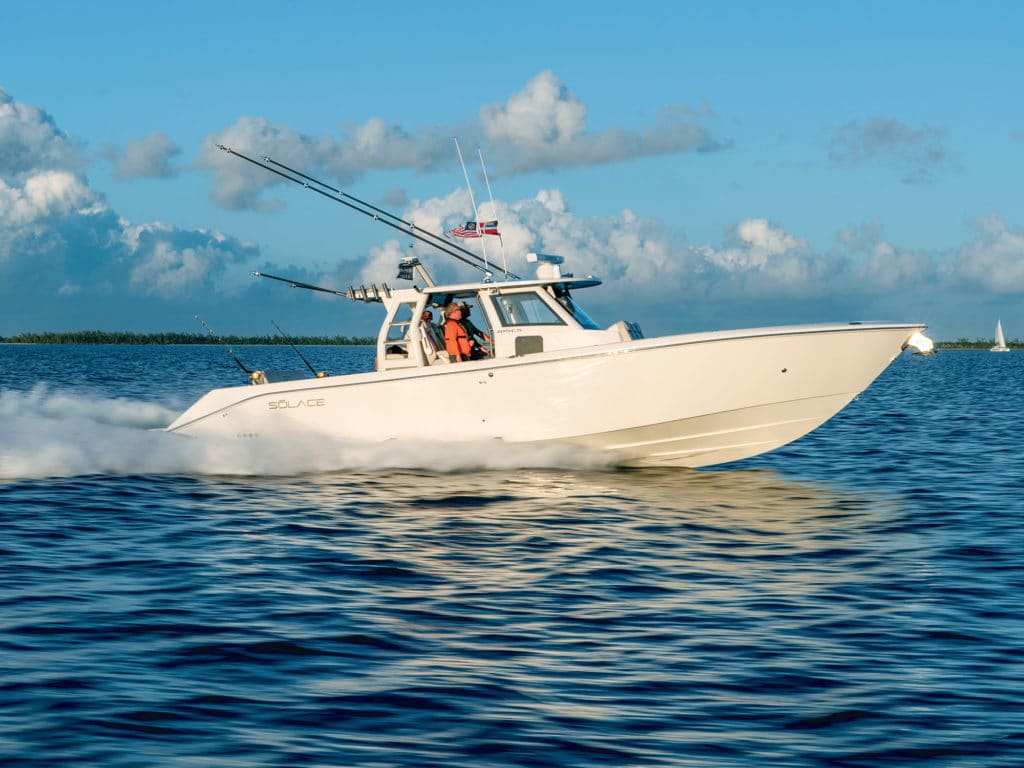
To better understand how these two marine engine choices perform powering a large center-console, and to discover if Volvo Penta’s diesel Aquamatic system can challenge outboards, we ran two Sōlace 41-footers to the Bahamas. We put over 600 sea miles on each boat over the course of four days. One boat, the Sōlace 41 CS, featured four Mercury Verado 400 outboards, and the other, a 415 CS, boasted twin Volvo Penta Aquamatic diesels. We ran in open ocean, crossing the Gulf Stream in rough conditions. We also beached the boats in quiet water. In between, we fished, snorkeled, cruised, took the boats to dinner and various marinas, and more, putting the two propulsion choices in as much a real-world comparison as possible. What did we find out? Will Volvo Penta’s Aquamatic displace the outboard as the power of choice for center-consoles? Read on to learn what we discovered during this extensive test.
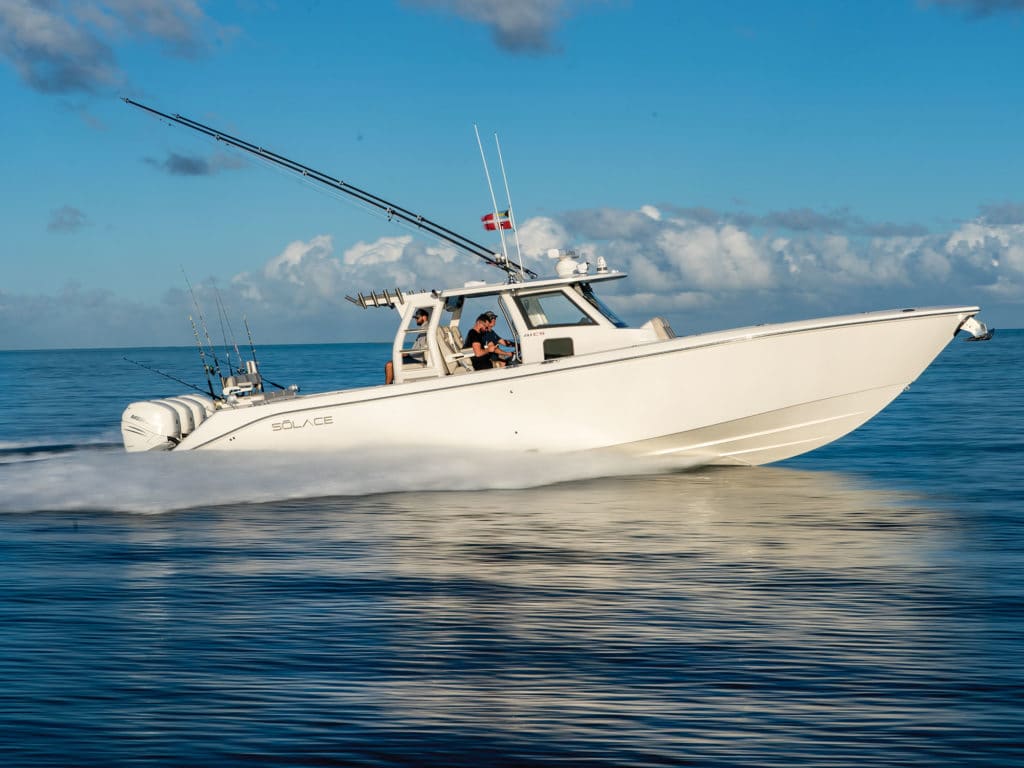
Seakeeping
We headed offshore from the Florida coast into the teeth of a stiff headwind that generated 4- to 6-foot seas right on our nose. Both Sōlace models handled the waves safely and with confidence. But our test team agreed that the Aquamatic-powered 415 CS made easier work of it. Unlike its outboard-powered counterpart with the engine weight aft, the D6 diesel engines turn the Aquamatic drives using jack shafts, which allows installing the engines several feet forward of the transom, under the cockpit sole. Moving the center of gravity largely results in the 415 CS running more level and with less pitching. Both boats could maintain the same speed, but the Aquamatic boat could do so while delivering more crew comfort.
We also discovered that the outboard-powered boat offered more bow trim for those times when one wants to optimize the ride for running in a following sea or trying to maximize speed.
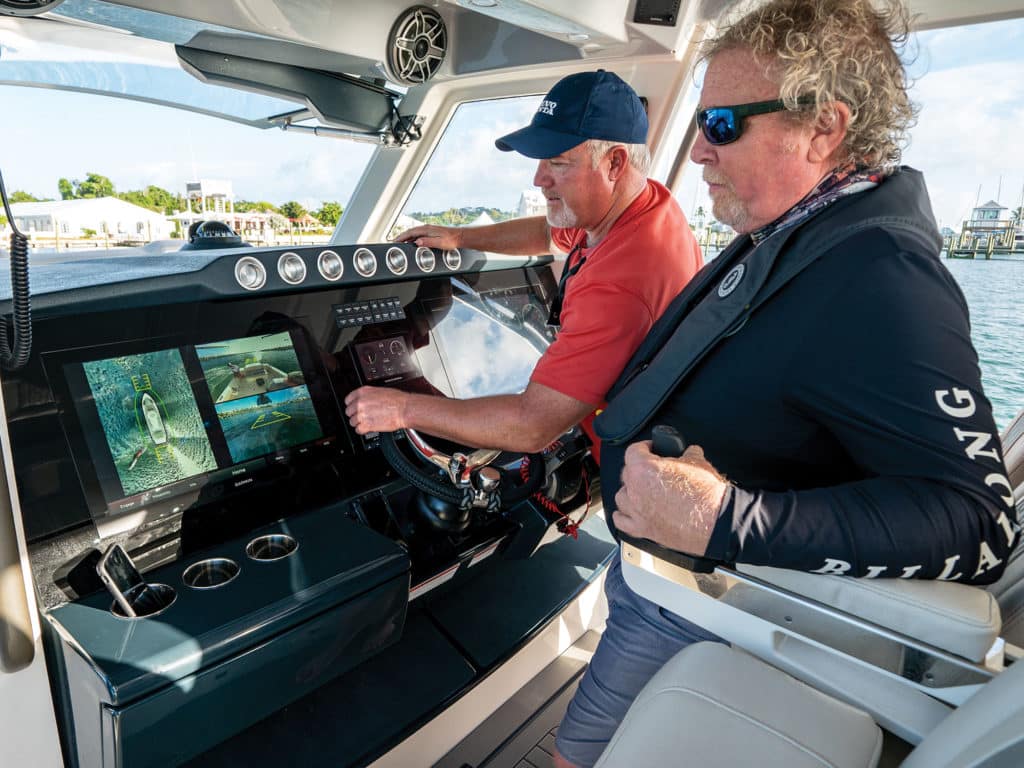
We record minimum planing speed when testing offshore boats. This is because the ability to slow down while retaining the maneuverability and dynamic stability provided by planing allows for better control and more comfort in rough conditions than going so slow as to operate in displacement mode (aka trolling speeds). The ability to hold plane at lower speed is better. We test minimum planing speed with full negative drive trim and the trim tabs fully deployed.
In our test, the Volvo Penta Aquamatic provided the Sōlace 415 CS with a minimum planing speed of 15 mph with minimal bow rise. The Mercury Marine outboards powering the Sōlace 41 CS provided a minimum planing speed of 17.6 mph with somewhat higher bow rise. Both are excellent numbers.
Top Speed and Acceleration
We loaded both boats to the hilt with people, gear, camera equipment and provisions for a week in the islands. Speed with lighter, typical loads will be significantly faster. The Aquamatic-powered 415 CS hit 50.6 mph at wide-open throttle. Accelerating to 30 mph took 12.2 seconds. Each Aquamatic turns a stainless-steel H8 Duoprop propset (Volvo Penta does not reveal Duoprop prop pitch) consisting of two contra-rotating propellers spinning through a 1.69-to-1 reduction. So, this Aquamatic propulsion package spins four propellers in two in-line pairs.
The outboard-powered Sōlace 41 CS hit 62.7 mph at wide-open throttle. Accelerating to 30 mph took 14.5 seconds. Each of the four outboards spins a 14.6-by-21-inch four-blade prop through a 1.75-to-1 reduction. That’s four individual propellers for this outboard-propulsion package.
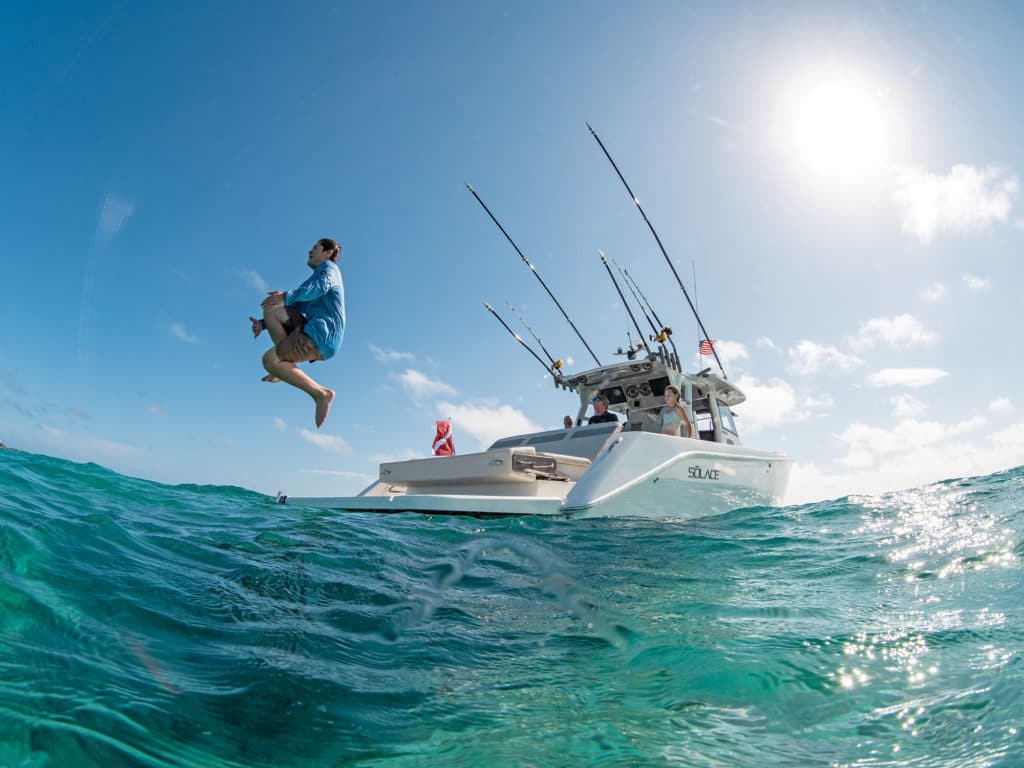
Exhilarating describes the outboard-powered boat’s top speed, a result of more power and more available bow trim. Surprising describes our initial reaction regarding the superior acceleration of the boat powered by the Volvo Penta diesel Aquamatic. We attribute this off-the-line performance to the D6’s high torque at low rpm and the Duoprop’s ability to transmit that diesel torque to the water better than conventional props. Finally, the reduced drag of two versus four gear cases helped.
Fuel Economy and Range
Because the power and torque characteristics of gas and diesel engines, as well as inboards and outboards, vary, it is helpful to make efficiency comparisons using boat speed as well as rpm. At 25 mph, the outboard boat netted 0.53 mpg, and the Aquamatic boat netted 1.13 mpg. At 30 mpg, the gas boat netted 0.6 mpg and the diesel boat 1.28 mpg. At 40 mph, we recorded 0.63 mpg and 1.2 mpg, respectively.
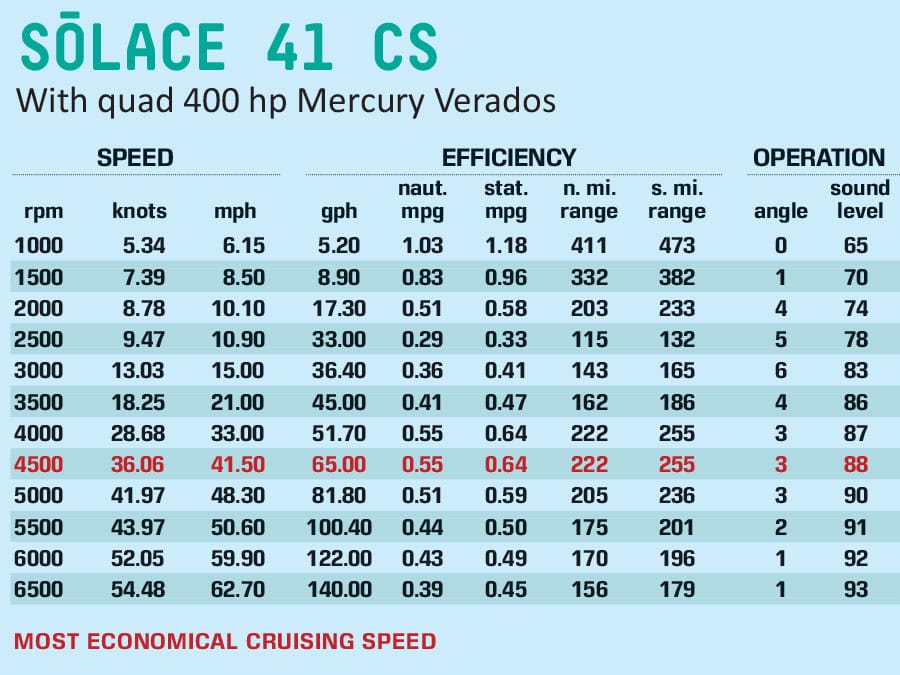
Note that the outboard-powered 41 CS carries 525 gallons of fuel, and the 415 CS carries 445 gallons. Also note that each D6 engine with an Aquamatic drive weighs about 1,760 pounds dry, whereas each Mercury 400 Verado weighs in at 670 pounds dry.
Also note that an outboard’s power rating describes prop-shaft power, and an inboard’s power rating describes crankshaft power. Each Volvo Penta D6 Aquamatic delivers 422 hp at the prop.
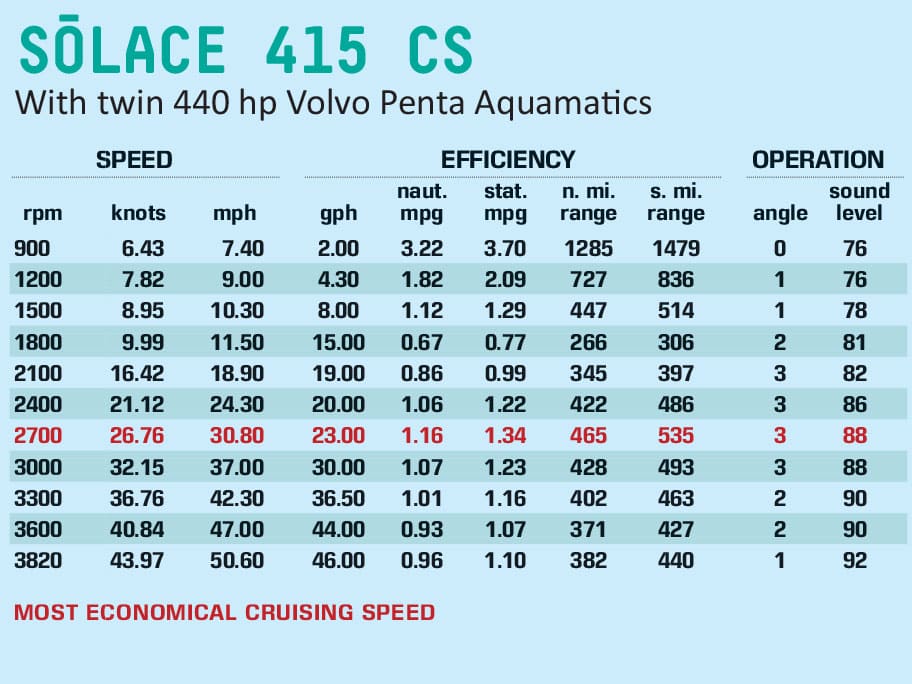
It became apparent the minute we arrived at Abaco Harbor Resort that the Volvo Penta Aquamatic-powered 415 CS offered much more range than the Mercury Verado-powered 41 CS. The 415 CS still possessed plenty of fuel after making the 215-mile run from Palm Beach to Abaco. The gas-powered 41 CS, while not running on fumes upon arrival, needed to fuel up during our stay so as to have enough fuel to safely conduct our tests over a couple of days and head back over the same 215 miles.
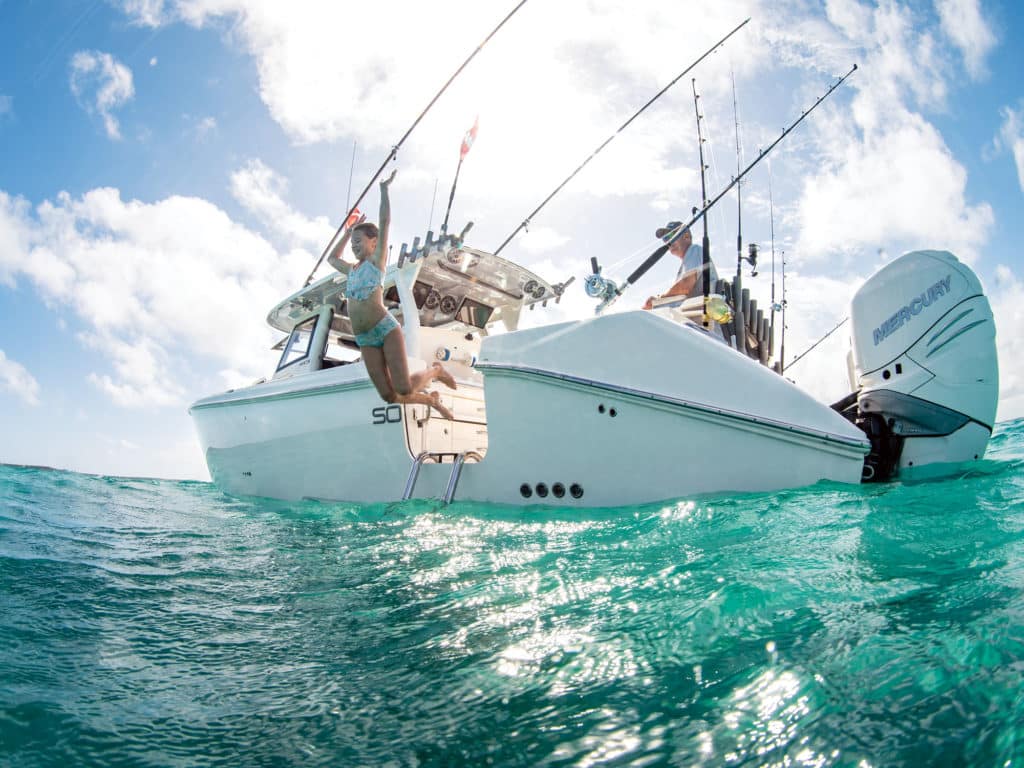
Noise Levels
You can view the accompanying performance charts for noise-level comparisons at various rpm and boat speeds. Simply put, each boat produced between 86 and 88 dB(A) at speeds between 25 and 40 mph, our nominally selected cruising range. At slow and no-wake speeds, the gasoline Verado-powered boat proved much quieter than the diesel Aquamatic, posting 65 dB(A) compared to 70 dB(A).
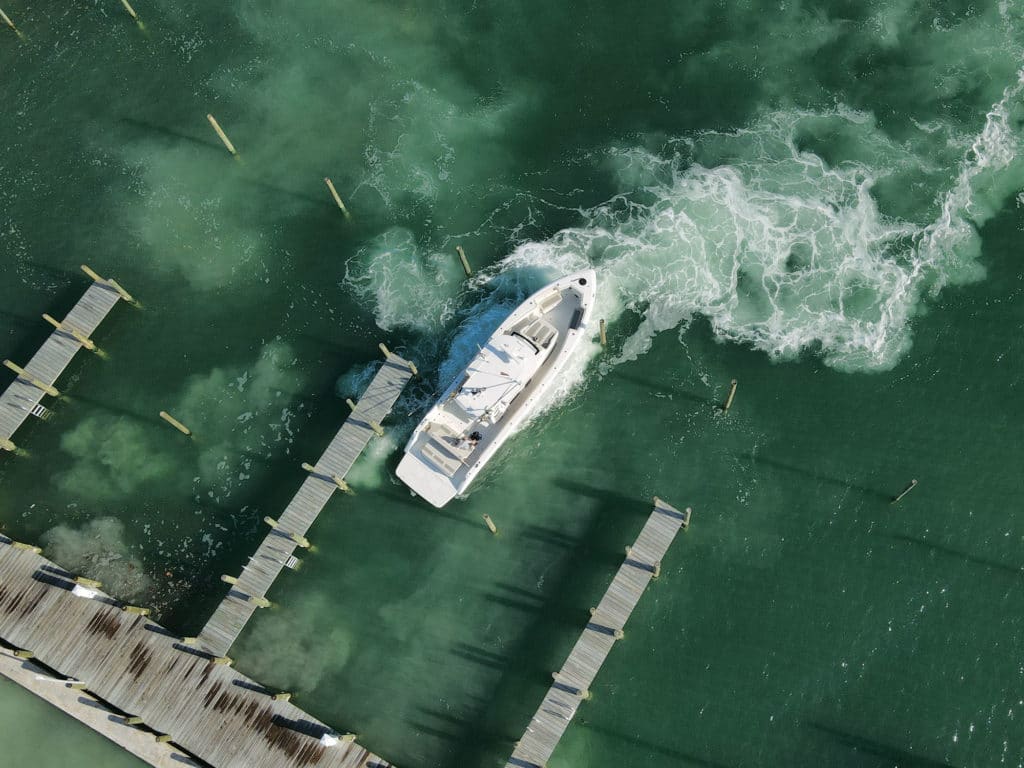
Docking
Both Volvo Penta and Mercury offer joystick systems for slow-speed, close-quarters operation of the boats they power. The Volvo Penta Joystick, integral with the Electronic Vessel Control (EVC) system, and Mercury Joystick Piloting for Outboard (JPO) system both enabled easier, controlled docking of our respective test boats. While there are some differences in features, both systems worked well in gusty, tidal Bahamian winter conditions.
Corrosion Resistance
The Mercury outboards tilt completely clear of the water. Additionally, the outboards are made from a corrosion-resistant aluminum alloy, bonded to control the electrical potential, and feature a multistep coating process called MerCathode. Their successful operation in salt water is long-proven.
“These are not your daddy’s marine engines,” Volvo Penta’s Arjen Steegstra states. The Aquamatic drives are made from a special alloy, bonded to control electrical potential and fitted with sacrificial anodes. The stainless-steel propsets are isolated to prevent corrosion, and a special coating protects the drive. Furthermore, an impressed current anti-corrosion system, the same one that has protected Volvo Penta IPS for years, thwarts the ravages on water-stored boats.
The D6 diesel engines are freshwater-cooled, made from a corrosion-resistant alloy, protected by sacrificial anodes and specially painted. Volvo Penta D6 diesel engines boast a long history of saltwater service.
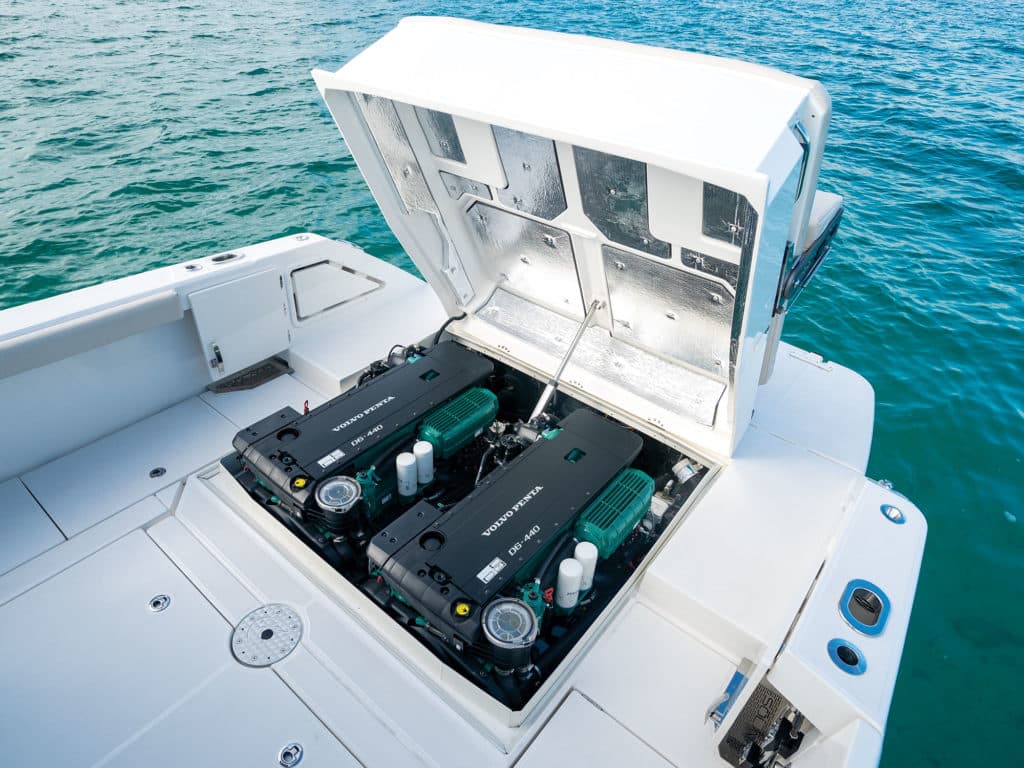
Serviceability
Both propulsion systems offer excellent electronic monitoring of engine functions and maintenance, with fuel contamination, oil levels and more easy to see via touchscreen MFDs without leaving the helm.
Access to the Verados from within the boat, or if out on the water, requires climbing over the transom. At the dock, you can step directly aboard the 41 CS’s aft platform.
Aboard the 415 CS, access to the Volvo Penta engines is easy from within the boat. The hatch (lounge) opens electrically with a switch or the provided key fob. Access to belts (via the stowage area in front of the engine box), filters, sticks, strainers and more proved easy to lay our hands on.
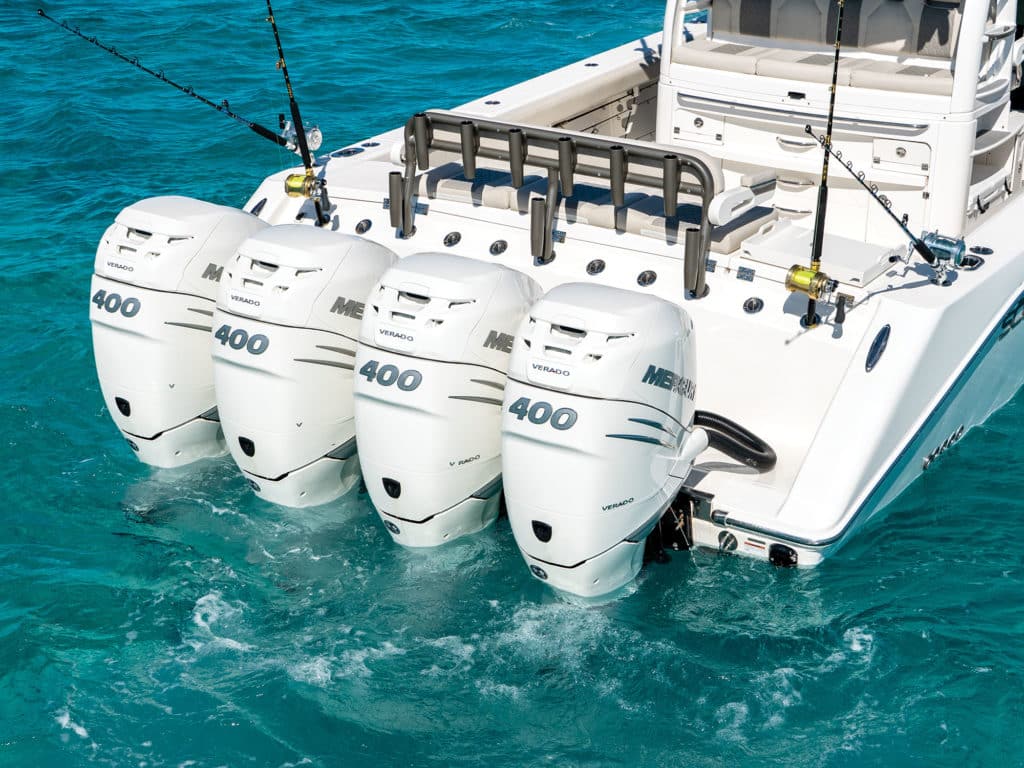
Effect on Layout
From the console forward, both of these Sōlace boats are the same, offering private overnight accommodations for a couple, and a comfortable head and shower belowdecks. A large multipurpose bow cockpit forward combines seating with stowage, and functionality for fishing, anchoring or docking is as good as can be found aboard boats of this type. It is aft where the layout—and perhaps the intended buyer—changes.
With four outboards mounted on the transom, the cockpit of the 41 CS affords a tremendous 83-square-foot unobstructed cockpit. Highlights include twin livewells in the aft corners, and a huge transom fish box to complement those in the aft cockpit sole and the bow space. There is mezzanine seating atop the tackle station/entertainment center, with its stowage, sink and optional grill. There’s hideaway bench seating for three at the transom, and with the huge cockpit and stowage space below the sole—which swallowed provisions for six for a week, plus spares and safety gear—the 41 CS boasts plenty of room to stow folding chairs and beanbags. The solid transom aft provides great security for fighting a fish in rough seas, or simply moving around the aft part of the boat while underway. Water access for crew or hauling aboard a big fish is through a generous portside door with a hidden ladder. This is a fishing cockpit that can also entertain.
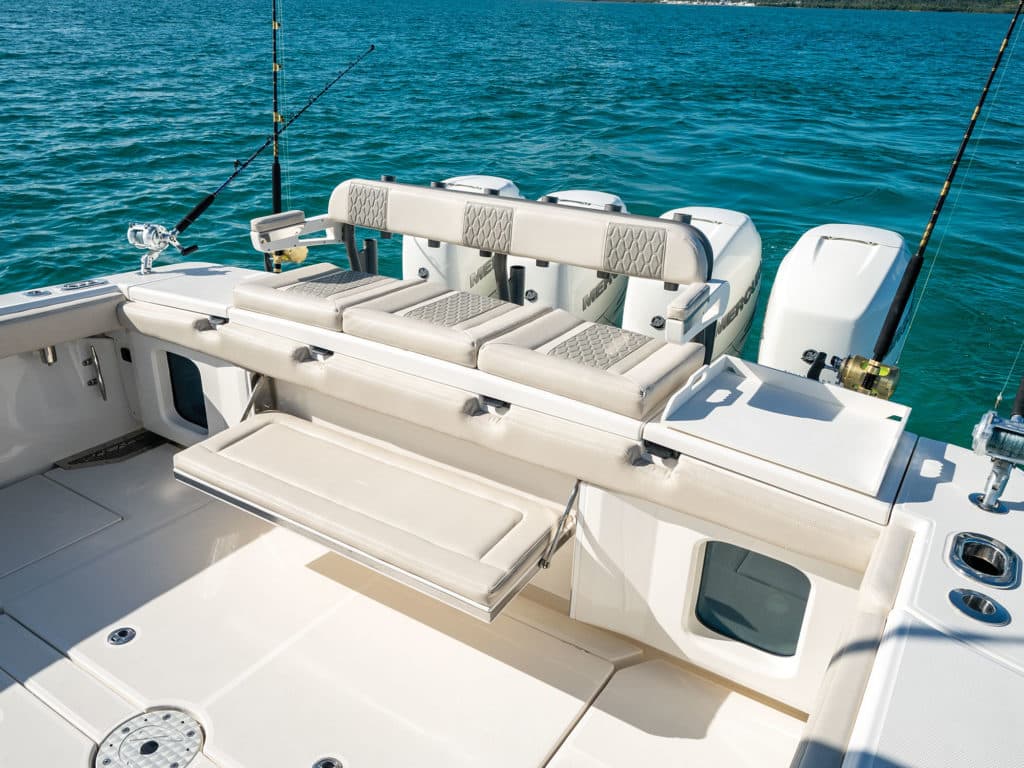
The Aquamatic-powered 415 CS sports twin D6 diesel engines installed in the cockpit, leaving two broad walkways to a transom that is wide-open for water access or easy dockside boarding and entertaining. The actual engine box is a plush convertible lounge that allows guests to recline, sit facing forward or aft, or lie completely prone. Unobstructed cockpit space is smaller than that aboard the 41 CS—about half the size between the entertainment center and the base of the lounge. You must add in the walkways, though, because they provide another 24 or so square feet of usable space on both sides of the lounge; we had no trouble working rods in the aft corner’s rod holders while trolling. We will say that the doors that close off each walkway on the 415 CS are less secure compared to the solid bulwark found aboard the 41 CS. Excepting the transom livewells and fish box, the fishing accoutrements are the same. The in-sole stowage is smaller, but still plenty big. In short, this is a multiuse cockpit optimized for entertaining and ease of water access that can fish too.
Read Next: New Solace 41 Equipped With Volvo Aquamatic System
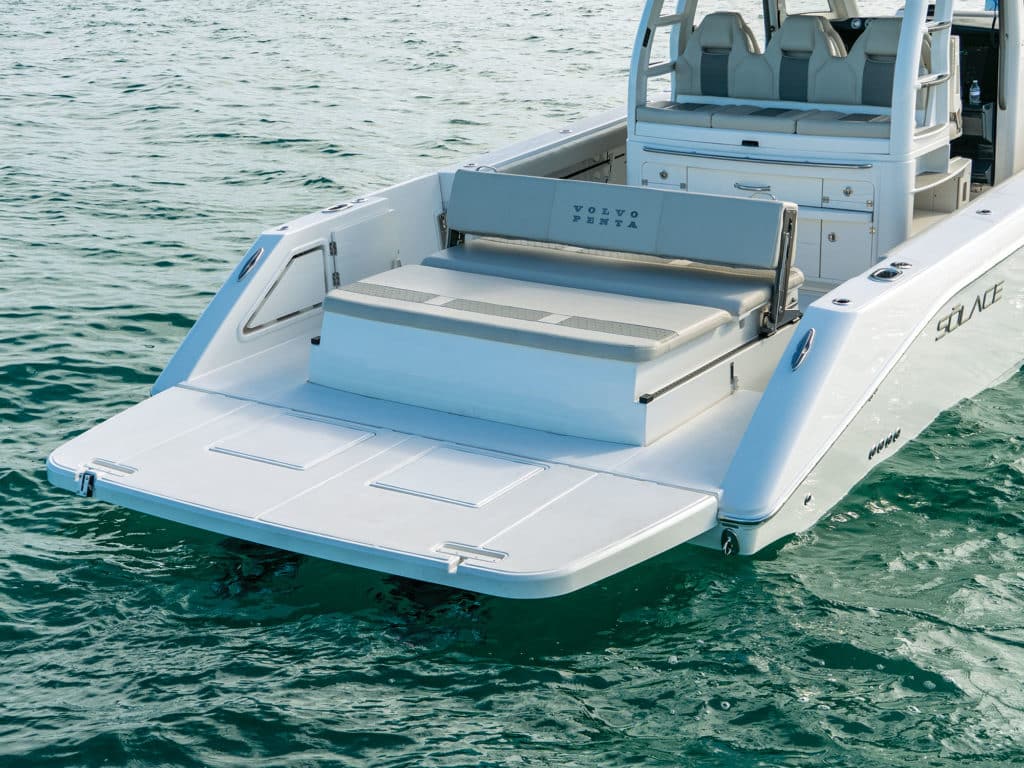
Conclusion
We set out to discover whether Volvo Penta’s diesel Aquamatic system could challenge gasoline-fueled outboards as power for a large center-console. We ran two boats as nearly identical as possible, each with different power, and covered 600 miles of ocean over four days while pursuing a wide range of activities. Our take?
We’ll leave aside yacht owners who might prefer an Aquamatic-powered vessel as a tender for its use of diesel fuel. Also, a Sōlace powered by Mercury’s V-12 600 outboards was not available, but we will look for an opportunity to run that boat soon. Certainly, outboards prove a better choice for those seeking the fastest boat, or the boat with the most stowage. But for boaters seeking maximum range, improved rough-water capability, or maximum access to the water for a variety of activities, a boat powered by Volvo Penta’s Aquamatic diesel system should absolutely make their short list to sea-trial. Pass the conch.

